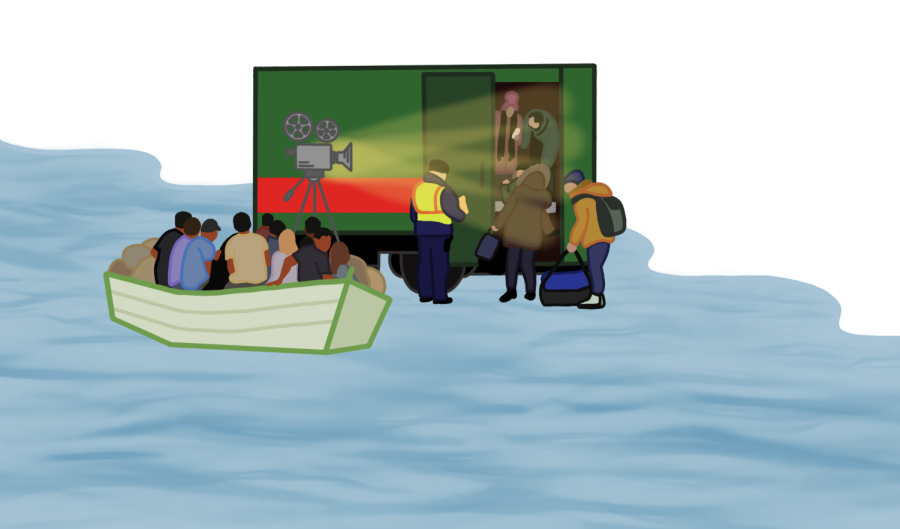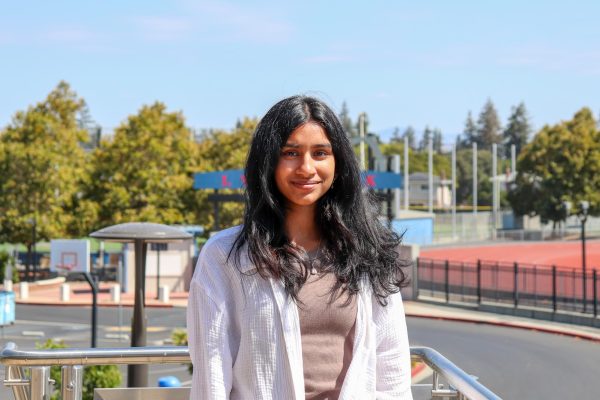Is the media coverage of Ukraine unfair?
Graphic illustration by Emma Constable
The inequitable coverage and difference in government responses are not easily simplified, but are at least partly a result of western double standards and racism, desensitization, a comparative lack of civil society as well as self-interest.
April 5, 2022
The age-old institution of war — which recently ignited ardent public outcry due to the Russian invasion of Ukraine — has in fact been an ongoing conflict for decades even prior to the invasion. The U.S. and Europe are no strangers to their own modern wars, yet the public has paid more attention to the ongoing Russo-Ukrainian war as compared to other international conflicts, partially due to the asymmetric reporting from the media. The inequitable coverage and difference in government responses are not easily simplified, but are at least partly a result of Western double standards and racism, desensitization, a comparative lack of civil society as well as self-interest. While some of these aspects increase the importance of the Russo-Ukrainian war as perceived by America, global conflicts that do not reflect these factors should also be assessed to an equitable extent.
News media, corporations, the public and the federal government have lent incredible support — financial, military and otherwise — to Ukraine in the face of the war. From economic sanctions against oligarchs and withdrawal of businesses from Russia to social media advocacy and fundraising, this support epitomizes the national awareness of global crises and the ability of the U.S. to champion humanitarian causes. While the outpouring of assistance is exemplary, it presents a stark contrast to the media’s response to other international conflicts.
America’s image as a democratic and peaceful nation belies the multiple wars it has perpetrated. Since the 2000s, America has involved itself in wars in Libya, Syria, Iraq, Yemen, Pakistan, Somalia, Kenya, Uganda and Afghanistan. These wars are not wholly unreasonable and unjustified; however, it is abundantly clear that media coverage in these areas is lacking, even though the U.S. has a direct connection to these conflicts. The current Yemen conflict stems from the forced transition of power from authoritarian President Ali Abdullah Saleh to Abdrabbuh Mansour Hadi. With economic strife, religious divides and political corruption, Houthi rebelled against the new president threw the nation into civil war. Although President Joe Biden has announced the intention to withdraw support of the Saudi-offensive that backs Hadi, the government has produced minimal action and complied with Saudi Arabia’s blockade in Yemen. The blockade has contributed to widespread famine in Yemen; according to the 2020 Global Humanitarian Report, Yemen has the most people in need: more than 20 million. And yet, while the U.S. has been complicit in the world’s worst humanitarian crisis numbers-wise, it fails to properly and equitably cover the war. The reasons behind this media deficiency is multifaceted and complex, but one component that plays a role is Western stereotypes and racism.
This double standard in national media can be seen through the words of many reporters, such as CBS correspondent Charlie D’Agata, who claimed that “[Ukraine] is a relatively civilized, relatively European city where you wouldn’t expect [war], or hope that it’s going to happen.” Similar viewpoints have been expressed on air, perpetuating the perspective that because the Middle East is seen as war-torn and blasé to violence, war is expected and of no particular concern. There are some truths to D’Agata’s statement: Although there have been many major conflicts in its history, Europe has seen less warfare than the Middle East in recent years. But his words also depict a worrying underlying sentiment: Because European countries are supposedly more civilized, they are more deserving of aid.
Like D’Agata, words from Al Jazeera presenter Peter Dobbie model social identity theory. Dobbie said that “what’s compelling [about photos of refugees trying to flee] is just looking at [refugees], and the way they’re dressed. These are prosperous, middle class people. These are not obviously refugees trying to get away from areas in the Middle East that are still in a big state of war…they look like any European family that you would live next door to.” The social identity theory describes the tendency of humans to self-align with certain social groups in an “us” versus “they” outlook. Applied to the situation in the Ukraine, it can be seen that Americans may identify more with Ukrainians under both the umbrella categories of Caucasian and a democratic government. Dobbie, like many others, empathizes more with Ukraine because of a greater relatability to Ukraine. Although both D’Agata and Dobbie’s statements have been recanted, with respective apologies issued, they nevertheless give a glimpse into the biases of modern American press.
The U.S. is now united more than ever before, even beyond party lines, in throwing its support behind Ukraine. During Biden’s State of the Union address, all Congress members gave a standing ovation when Biden affirmed America’s backing of Ukraine. Yet this same bipartisan rallying has never emerged for the Middle East and peace efforts there. It is hypocritical to urge for military resistance to foreign occupation in Ukraine but denounce those who do the same in the Israel-Palestine conflict. America has steadfastly supported Israel, yet failed to acknowledge the horrific violence on both sides. While the U.S. has issued sanctions against Russia, within the Israel-Palestine conflict, the government actively resists calls for sanctions or investigations on Israel, even though both places have been deemed by the United Nations as perpetrators of war crimes and human rights violations.
The international community has also expressed support for Ukraine. Sky News, a British news channel, aired a video of Ukrainians concocting molotov cocktails, even taping a discussion of how styrofoam helps the molotovs stick to vehicles. However, a similar video originating from the Middle East would have likely been flagged as terroristic activity.
Other videos and photos have also trended on social media, a prevalent platform of media coverage, despite being a double-edged sword: In advancing the truth, social media algorithms have perpetuated doom-scrolling and confirmation bias. Viewers are fed gory and shocking content without context as well as content that corroborates their pre-existing beliefs, simply because this content causes people to stay on the platform for the longest time. As a result, the racist and prejudiced implications seen on news channels is protracted and likely spread through social media, garnering sympathy for European refugees while overshadowing others.
“A lot of news is biased or exaggerated on social media,” sophomore Surya Saraf said. “Many posts are just trying to elicit some kind of response from the audience, such as through huge generalizations, even though the posters themselves aren’t very knowledgeable.”
News organizations and the public at large should check their biases and introspect on how these ingrained stereotypes affect the way different conflicts are viewed. Desensitization is also a major factor: Americans have heard about the Middle Eastern wars for many years, as opposed to the novelty brought with the war in Ukraine. It is understandable why this may be the case, but it is all the same disheartening that the public’s attention span of some of the largest global conflicts has waned. Desensitization often engenders a normalization of violence, leading to the double standards in news reporting, which circles back to desensitization. This self-sustaining system of events must be broken, and it can start with individuals being mindful of their predispositions.
However, racism, social identity and novelty fall short of fully accounting for the disparity in media coverage. While they certainly hold water, they also fail to address a contradiction: Why was the world uninterested in Russia’s 2014 invasion of Ukraine?
Russia’s 2014 invasion, which led to the annexation of Crimea, was a response to the removal of pro-Russian Ukrainian President Viktor Yanukovych. It was a novel conflict between European nations, but condemnation of Russia’s actions never reached the same heights as today. In fact, reporting of the Middle East eclipsed that of Ukraine. The same goes for Russia’s invasions of Georgia and Syria, both of which passed by the limelight.
“These classical explanations don’t necessarily explain the real reasons why we are paying more attention to Ukraine now,” West Valley College Political Science instructor Jamilya Ukudeeva said. “The real explanation, I think, is the concept of civil society.”
Civil society refers to the forming of societal groups by like-minded citizens without affiliations with the government or corporate sector. Examples include labor unions, nonprofits and independent journalists. According to The World Bank, Ukraine’s civil society participation has increased dramatically between 2014 and 2020. Civil society reflects a nation’s freedom of expression and capacity to self-organize, and with it, the ability of citizens to remedy national issues; in this case, the issue is foreign invasion. As compared to the 2014 invasion, Ukraine has now been able to more effectively mobilize civilians into taking action, such as through on-the-ground reporting. In fact, the U.S. Office of Transition Initiatives has supported democratic efforts in Ukraine since 2014, and in the 2022 Ukraine Supplemental Appropriations Act, the U.S. has provided $120 million for Transition Initiatives in Ukraine to support activism, journalism and transparent media of Russian aggression and $25 million to combat disinformation. This, in turn, has raised awareness of the war in a global context and — to some extent — generated sympathy. Comparatively, regarding the overall civil society participation from 2006 until 2020, Syria, Iraq, Yemen and Pakistan all averaged scores below the world median.
“Ukraine has been a democracy — a young, unstable, imperfect one, but still a democracy — whereas Syria has a highly controlled and authoritarian government,” Ukudeeva said. “In terms of civil society, an unstable democracy tends to have a stronger civil society than a complete authoritarian one.”
Social media functions as a channel for civil society participation — those engaging in civic actions can express their viewpoints of the situation at hand — and has proven to be a constructive and far-reaching medium at that.
“Today, anybody with a camera and internet connection can be a reporter,” Ukudeeva said. “Public response has been very strong due to the information pouring out of Ukraine and through social media. Emotional images and well-put-together videos really help to mobilize the world.”
Nevertheless, social media can also be used destructively in the wrong hands. It is not just algorithmic exploitation that gives rise to concern, but also that of platform content creators. Opinions become increasingly indistinguishable from facts, and media consumers are unlikely to verify the claims made by content creators. While the advent of the digital information age has disseminated news to a larger audience, it has also disseminated misinformation and disinformation at alarming rates. It is integral that viewers also take in media from reputable sources and examine multiple points of view to combat the one-sidedness of both social media and newscasts.
However, the focus on nations with a thriving civil society both within and outside of social media creates a ruinous feedback loop: Theaters of war, which are gripped by a totalitarian regime, have low civil society participation and are thus unable to garner the aid needed to break free from an autocratic rule. Consequently, totalitarianism in such places is eternalized, leading to even less civil society participation, and this cyclical process is continued. It can be said that nations with low civil society participation generally need the most aid to combat tyranny, so greater public attention should be diverted to helping these conflicts. In this regard, the U.S. Office of Transition Initiatives has also supported countries beyond Ukraine in their efforts to advance democracy: $54.7 million has been used toward saving lives and increasing transparent reporting within Syria, with current programs in Libya, Haiti, Ethiopia and El Salvador to name a few. The work that has been done heretofore is incredible, but there is much more still needing to be accomplished, for which the public can help spread the word about conflicts regardless of ethnicity, novelty and foreign intranational advocacy.
Ukraine differs from the Middle East in more than just civil society, but also political unification. President Volodymyr Zelensky promotes the Ukraine cause, and Europe as a whole has also seen unification through the European Union, while many Middle East nations have multiple clashing political leaders. Without proper political representation, it is difficult to winnow through the flood of dissenting voices. However, this is all the more reason that proper coverage of the Middle East, Africa and other conflicts beyond Europe is so crucial: With so much varying information out there, the public is unable to easily comprehend the situation abroad. The responsibility falls upon news media and outlets to factually convey the news and bring attention to what is important.
Another reason that contributes to America’s spotlight on Ukraine is a greater vested interest in Ukraine. Self-interest is, at heart, the purpose of any government; a government should serve its citizens first and foremost. During the 2014 invasion of Ukraine, the U.S. was more occupied by the happenings of ISIS, Afghanistan and the Israel-Gama war. This contrasts with the current Russo-Ukrainian war, which is seen as a more critical peril to America than other conflicts simply because of its international nature. This includes the immediate threat to American allies such as NATO, the looming threat of a third world war and nuclear war and the direct involvement of global superpowers. Russia is also seen as militarily competitive with the U.S.; the Cold War serves as an example of the tense arms race. In spite of Russia’s looming military power, it shockingly failed to take Ukraine by storm. Coupled with the threat factor, public interest has piqued to higher levels.
Impairment to Ukraine’s trade and commerce also spells implications for the American and global economy. According to Statista, Ukraine was the fifth largest exporter of wheat in 2020.
“With the nature of globalization, even if the U.S. is not a major consumer of Russian oil and gas or Ukrainian wheat, global prices will fluctuate and ripple to America,” history teacher Steven Roy said. “There’s going to be economic repercussions since the war is going to affect everything.”
In a purely egalitarian sense, it is unrealistic to expect the U.S. to address all humanitarian issues equally; not only does the U.S. have limited resources that can be expended for foreign issues, but the U.S. has to be careful in the balance between respecting foreign sovereignty and punishing violations of human rights. These obstacles unmistakably hinder U.S. actions; even now, the federal government is measured in its sanctions against Russia, clearly taking caution to not hastily provoke anything. In spite of these challenges, the U.S. should endeavor to help — as much as it can, wherever it can — in order to aid humanitarianism beyond borders. The public is rightfully worried and gripped by the ongoing events in Ukraine, but this media dominance has caused the public to overlook other conflicts, including Tunisia’s president becoming more dictatorial, Saudi Arabia’s mass execution of 81 men, the U.S. working to restore the Iran nuclear deal, an accidental missile fired by India toward Pakistan, the U.S. acknowledging the violence against the Rohingya people as genocide and unrest in Kazakhstan.
The Russo-Ukrainian war has rocketed into the public purview in light of Western double standards, self-interest, social media and the formation of civil society in Ukraine. While the fish-eye lens over Ukraine has led to public assistance, it is vital that similar, previously-overlooked international conflicts be brought into the public consciousness.






































































